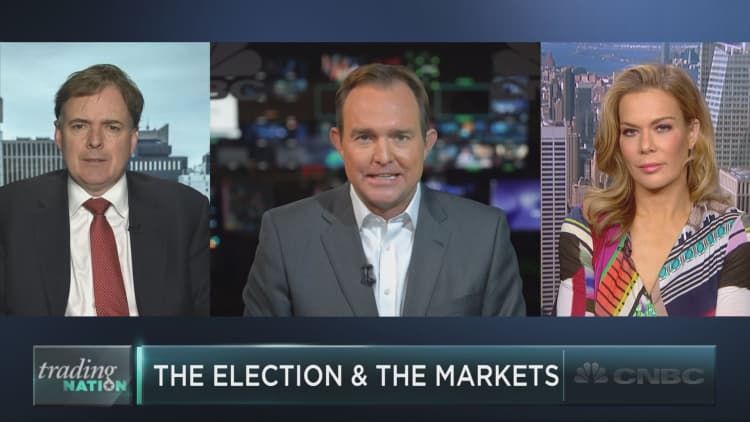
Based on the amount of fervor surrounding the election, and the extent to which markets are reacting to every major news event in the race, one might expect that markets anticipate a big move based on the outcome.
After all, the is rising more than 2 percent on Monday alone, as a Hillary Clinton win looks somewhat more likely, now that the FBI has reiterated that the Democratic nominee should not face criminal charges.
But forward-looking options traders appear downright blase. The expected move for the S&P between Monday afternoon and Friday is just 2.4 percent, based on the price of an options trade known as a "straddle."
This is a structure that entails the purchase of a bullish option and a bearish option that are both trading in line with the level of the index, and both expire after Friday trading.
Since this trade grants one the right to buy the index at a certain level, as well as the right to sell it at the same level, it will show profits so long as the market either rises or falls by more than the amount laid out — in this case, about $50 for the S&P 500, or $5.25 for the SPDR S&P 500 ETF (SPY) (note: each options contract actually has a multiplier of 100, but that doesn't change the math).
If one thinks the market will rise or fall by less than 2.4 percent, one should sell these options; if one thinks it will rise or fall by more than 2.4 percent, then one should buy them. This open-market function means that the price of the "straddle" should converge at traders' consensus expectations on how much the market will move.
To be sure, what's notable is how small the expected move is. Strategists' broad expectations were for the market to rise by about 3 percent on a Clinton win, and fall by roughly 10 percent if Republican nominee Donald Trump were to prevail. Both of these are larger than the current expected move on the week. (And of course, the 2.4 percent shift also incorporates the potential for other events to move the market.)
For Dennis Davitt, an options trade at Harvest Volatility Management, it appears that the market is beginning to price in a Clinton victory — so some of that 3 percent move is coming early.
"The options market says 'Hillary won, move along, nothing to see here,'" Davitt told CNBC on Monday.
Indeed, this would explain the S&P's substantial jump, as well as the drop in expected volatility (and consequently options prices) on Monday. This after the CBOE gauge of implied volatility rose for nine straight sessions, the first time that has ever happened going back to the beginning of the data series in 1990.
Yet for Davitt, the straddles are "still a good purchase," since "what the market's telling me is not what my ample gut is telling me." That is, Davitt expects to see a surprise Trump victory.
"I don't see anything definitive out there that's going to put Hillary over the top," he said.
In other words, keep your seat belts fastened.






